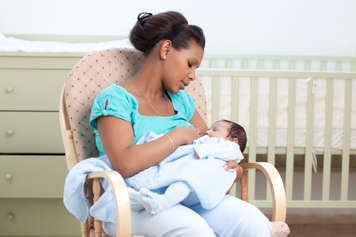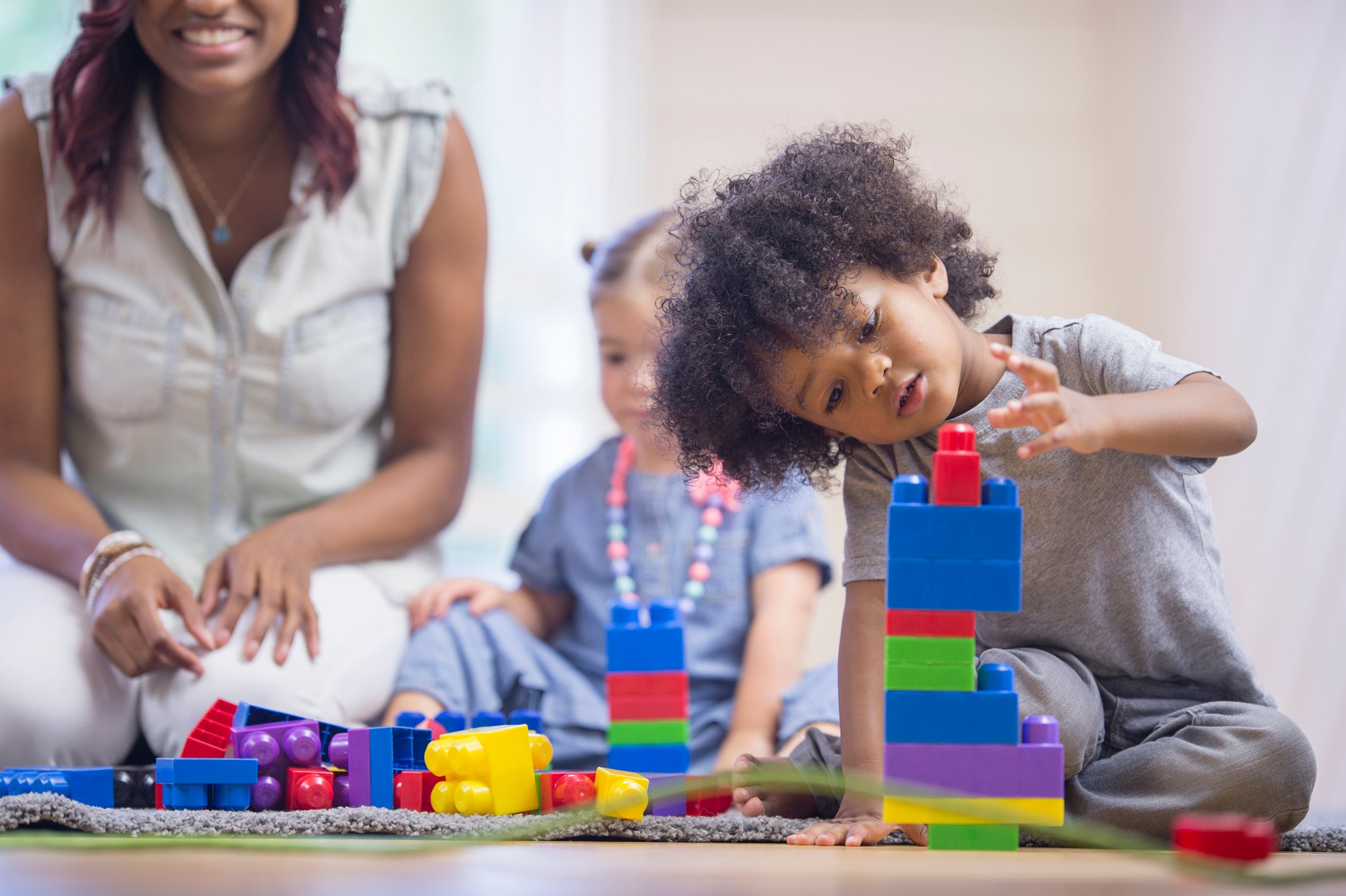Every baby develops at their own pace and may feel differently on different days. A baby born prematurely may meet these stages a bit later than a full-term baby. A baby’s behavior can tell you what they need to feel safe.
The 8 sensory systems
Babies take in sensory information (what they see or hear) from the environment around them, make sense of it and then use it to help them understand themselves and how they can influence that environment. This helps them to participate in everyday activities such as play or sleep.
There are 8 sensory systems through which babies gain information from their environments:

Tactile system (touch): Provides information regarding shape, size, texture and temperature.

Vestibular system (balance and movement): Provides information about where our head is in relation to gravity and about the speed and direction of movement.

Proprioception system (body awareness): Provides information from muscles and joints, tells us where our body is in space and about how much force to use for activities. E.g., we do not have to look to know our legs are crossed.

Visual (sight): Helps babies detect colors, shapes and social cues.

Olfactory (smell): Helps babies recognize and enjoy good food and avoid bad food.

Auditory (hearing): Provides information on the quality and direction of sound.

Gustatory (taste): Works with the olfactory system to recognize food that tastes good and bad.

Interoception (sense of pain, hunger, temperature): Provides information from the body such as thirst or exhaustion.
For example gentle touch (tactile system) can be calming, while tickling is alerting. Slow rocking (vestibular system) at bedtime can be calming. Vigorous jumping or bouncing can be alerting and help babies to attend and learn.
How babies perceive sensory information
It is important to understand how individual babies perceive sensory information. With poor processing, babies may bump into furniture (vestibular and proprioceptive systems) as they roll, crawl or walk, as they have not yet developed a good awareness of where their body is in space.
Some babies are very sensitive to sensory input. They may become more agitated or distressed than other babies when they hear loud noises or are around lots of people (auditory and visual systems), or in reaction to clothing labels (tactile system) which may feel like knives cutting into their skin.
Other babies are less sensitive to sensation. Some do not notice pain (tactile system) when burned or bumped.
Some babies crave more calming input such as slow rhythmical movement (vestibular system) while others may crave more aggressive and alerting input such as rapid movement and swinging.
Observe your child to learn what they seek or avoid. They may feel and behave differently from one day to the next. Follow your child’s lead and progress slowly to help them become used to sensory inputs that may be perceived as uncomfortable.
Organize the suggestions below around typical daily routines so that they are easier to carry out. Watch for reactions to play. If your child becomes wild or upset, they may be over stimulated. Deep hugs or pressure, and slow rocking (calming) are useful strategies to try at such times. Feeling comfortable and safe can help with self-regulation (ability to manage emotions and behavior).
0-3 months
Tactile
System fully developed at birth. Babies prefer soft gentle touch and cuddles, crave skin to skin contact, calm with touch; palms grasp reflexively in response to touch.
Activity suggestions
- Skin-to-skin contact, touch with different textures; daily gentle massage
- Provide touch input during daily routines such as bath time and diaper changes, naming body parts
Vestibular
Various reflexes, such as fencing position, affect movement in first 6 months.
Activity suggestions
- Variety of positions; movement such as rocking, swaying while holding
- Become aware of reactions to various movements, which ones help to calm vs. alert (wake up) the baby
Proprioception
Babies begin to smile, imitate facial movements, suck to drink.
Activity suggestions
- Move body arms/legs together and then apart during play and daily routine, gently
- Play and carry in different positions
Visual
Babies cannot see all colours at first; they prefer black and white and human faces.
At 1 month, babies can focus short distances (approx. 1 foot).
At 2 months, they can follow a toy when it is moved close to face. Eye movement is not yet fully coordinated so may seem cross eyed at times; beginning to make eye contact.
Activity suggestions
- Simple patterns of black and white on toys, books; mobiles and overhead gyms
- Eye contact; smile at baby, read and sing to baby
- Carry baby so they can see where they/you are going
Olfactory
Fully developed sense; babies will turn toward source of food; prefer pleasant smells (e.g. milk vs. spoiled food); prefer what mother ate during pregnancy.
Activity suggestions
- Familiar smells, such as breast milk, are calming; give baby blanket that parent has slept with
Auditory
Fully developed at birth; babies prefer the sound of human voices and are calmed by soft voice; startled, sometimes cry with loud noise; begin to coo, make sounds such as oo, ah.
Activity suggestions
- Coo, talk, and smile, sing songs, play music, dance with infant, making eye contact
- Squeaky toys or toys that make noise
Gustatory
Babies are attracted to sweet taste as breastmilk as opposed to sour or bitter; anticipate feeding.
Activity suggestions
N/A
Interoception
Babies will be calm but react to discomfort from hunger, fatigue, dirty diaper.
Activity suggestions
- Attend to physical needs, cuddle, keep warm
- Attend to environmental input; e.g. bright lights should be dimmed for sleeping
3-6 months
Tactile
Babies explore objects through touch and bring some to mouth.
Activity suggestions
- Provide opportunities to explore several different textures; use different toys, blankets, fabrics
- See which tactile experiences are calming or soothing (soft blankets vs. rough burlap)
Vestibular
Babies are moving and balancing in various positions, against or with gravity; beginning to sit by 6 months.
Activity suggestions
- Lift up and down, swing side to side; slow rhythmical movement, rocking to calm; e.g. rocking chair, in parent’s arms vs. active or vigorous movement to 'wake up'
Proprioception
Babies can use both sides of body together, learn push and pull.
Activity suggestions
- Gentle push pull games with blankets, clapping, pat a cake
Visual
Tracking objects and people: at 3 to 4 months, babies can focus on an object or face from 1 to 2 meters away and begin to see a full range of colours.
Activity suggestions
- Hold baby face-to-face while you talk and make silly faces
- Carry baby so they can see out; point out and name objects
Olfactory
Interested in smells of food, stronger reaction to bad odors.
Activity suggestions
- Timely diaper changes
Auditory
Babies alert to sounds and begin to imitate. Their various needs elicit different cries. They begin to babble.
Activity suggestions
- Imitate and engage in vocal play; listen to music
- Talk to baby– narrate your day. Point out objects while you talk
Gustatory
Beginning interest in new flavors such as salt, and in others’ food.
Activity suggestions
- Begin to offer age appropriate purees of iron rich foods, fruits and vegetables between 4-6 months
Interoception
Beginning of routine developing for feeding, napping; fussy when uncomfortable.
Activity suggestions
- Attend to environment to ensure comfort and help with establishment of routines; e.g. lighting, noise, smells such as dirty diapers
6-9 months
Tactile
Learning about properties of objects with mouth and hands, explores different aspects of new objects such as shape, size and texture.
Activity suggestions
- Provide a variety of textures during everyday activities; e.g. through clothes, toys, teethers, food, bathing; toys of different shapes and sizes
- Water play, pouring, stacking
Vestibular/Proprioception
Greater variety and control with movement in different planes; more bouncing, rocking movement in various directions. More experimenting with force that is needed to play, hold own bottle or put pacifier in mouth.
Activity suggestions
- Maintain safe environment for baby to move, explore, without bumping into corner of coffee tables etc.
- Use variety of positions to carry baby, play with baby, to take baby outside
- Push pull toys
Visual
Developing ability to focus when objects and people are close or distant.
Activity suggestions
- Enrich play using different colors, shapes, and sizes of toys and encourage exploration of these while baby is in different positions; peek a boo game
Olfactory/Gustatory
Greater interest and reaction to smells and tastes and learning to recognize familiar ones; reaches for food, refuses bad smelling food.
Activity suggestions
- Introduce new smells, such as grapefruit or vanilla; can try essential oils
- Introduce new foods slowly, paying attention to reactions and preferences; add texture if seems to dislike some food
Auditory
Beginning to recognize familiar words, voices and where sounds are coming from.
Activity suggestions
- Two-way communication – read to or talk with baby, taking time to allow baby to look at pictures you are referring to or mimic what you are saying. Mimic their vocalizations
- Talk about what you are doing; use music
Interoception
Teething discomfort; lasts longer between meals with solid foods.
Activity suggestions
- Consistent routine; teethers, chew toys
9-12 months
Tactile
Ability to grasp developing, e.g. rattles, teethers, toys that can be manipulated.
Activity suggestions
- Name properties of objects baby is touching – rough, soft, round, jagged, etc.
- Provide variety of textures and name them: food, toys, clothes, sponges, blankets etc.
- Encourage to feed themselves (feel variety of textures in mouth and hands)
- Pat-a-cake game
Vestibular/Proprioception
Babies are more curious active and mobile; getting up against gravity; developing motor skills to move and manipulate objects.
Activity suggestions
- Obstacle courses: Let them crawl or walk around, between, under, on top of obstacles; encourage various positions, such as crawl, lie, roll
- Push-pull toys and games that call for greater force (add weight to moving toys)
- Gentle rough and tumble play such as riding on parent’s back (parent on hands and knees); dancing together to music
- Calming slow swinging such as in hammock or blanket held by 2 people
Visual
Development of visual skills, depth perception.
Activity suggestions
- Continue to enrich development by pointing out objects and showing where toys are kept
- Peek-a-boo; face mirror – name body parts
Olfactory/Gustatory
More particular in choosing smells.
Activity suggestions
- Experiment with softer foods (e.g., soft fruit, vegetables) and finger foods
- Introduce new flavors
Auditory
Uses gestures to make needs known. Understands many words.
Activity suggestions
- Cause and effect toys (e.g., ones that make noise when you touch them, objects to bang together, toys that play tunes)
- Continue to engage in 2-way communication, taking turns in talking, playing, singing
- Dance to music with rhythm, holding hands
Interoception
Experience teething pain; sometimes stomach issues in reaction to new foods (diarrhea, constipation).
Activity suggestions
- Try to address discomfort as best as possible
12-18 months
Building on the descriptions and activity suggestions for 9-12 months, as you baby develops in every way. Positive reinforcement to encourage participation, creativity and learning. Have fun encouraging independence. Babies help with dressing and feeding themselves.
Tactile
Activity suggestions
- Use bubbles to catch or pop; water play in bathtub or water play table
- Use shaving cream on table or mirror; practice drawing in it with hands, fingers, or feet
- Put toys or blocks of different textures, sizes, smells, sounds, into a basket and allow baby to explore
Vestibular
Activity suggestions
- Encourage climbing, jumping, slides, going up and down stairs, but stay close to ensure safety
Proprioception
Activity suggestions
- Weight down boxes or toys and have baby push them as they practice walking
- Kick, catch throw, using different sizes and weights of balls
- Push pull toys such as large Lego blocks
- Head and shoulders knees and toes game
- Help baby learn techniques to self sooth (e.g. come for a hug, have a drink of water, hold a favorite blanket)
Visual
Activity suggestions
- Name pictures in a book baby knows and wait for baby to find them; eye spy game
- Be creative in using blocks and crayons and describing what you are both doing
Auditory
Activity suggestions
- Play games such as identify that sound (e.g. bird chirping, dog barking)
- March to music, clap hands (baby’s and yours)
- Name objects as you go for walks
- Quiet times in day without music or TV, just talk or read together etc.
Interoception
Activity suggestions
- Maintain consistent schedule (e.g. nap and bedtime)
- Help to try more foods

